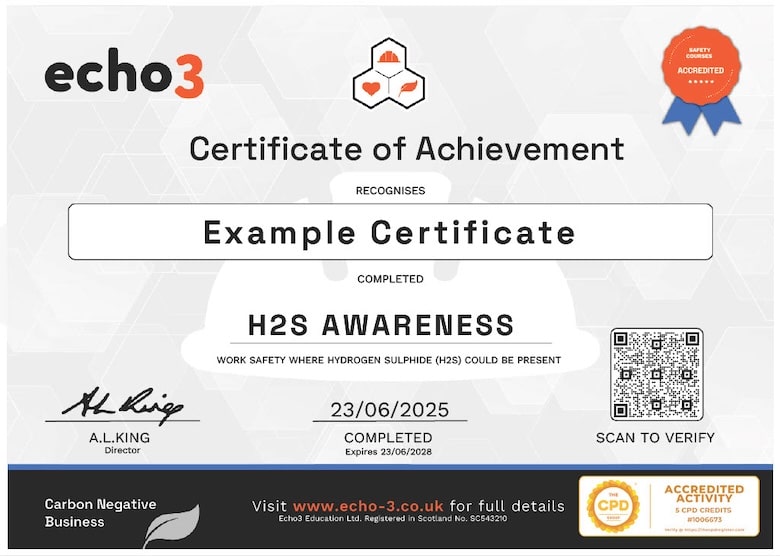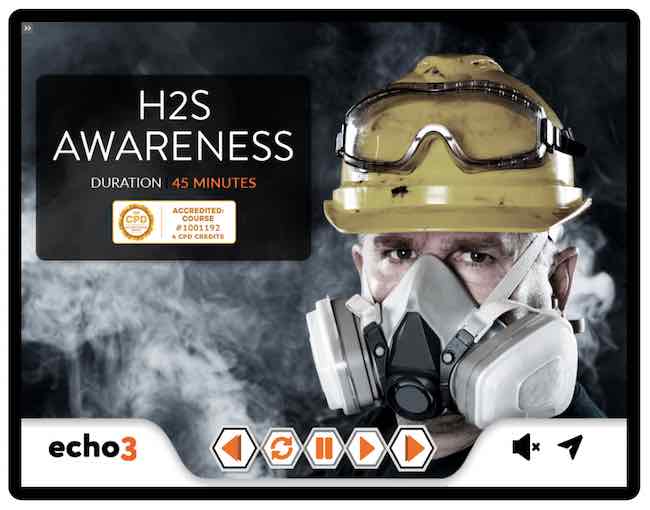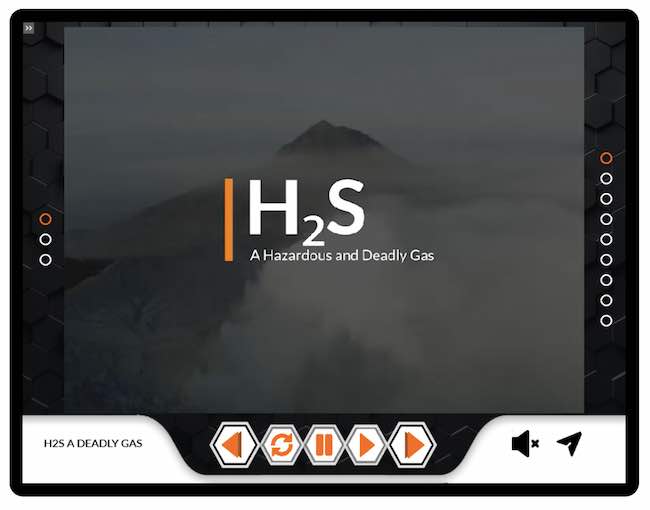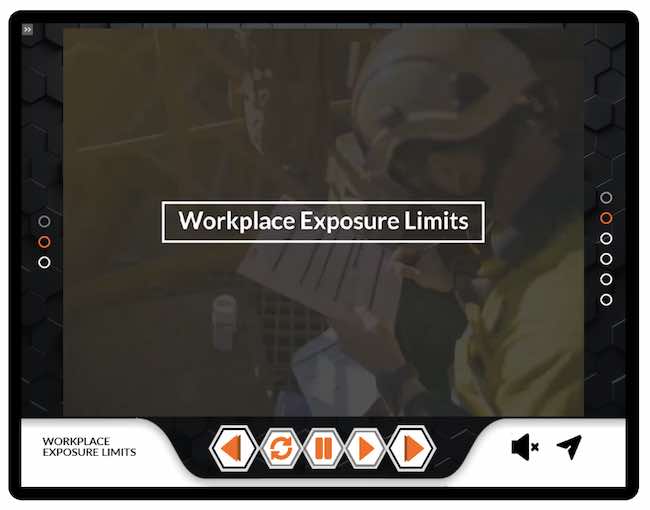H2S Awareness Course
This online H₂S Awareness course (Hydrogen Sulphide) equips learners with the essential knowledge to work safely around hydrogen sulphide by increasing awareness of its dangers, teaching how to recognise hazardous concentrations in the atmosphere, and outlining the correct actions to take when unsafe levels are detected.
H₂S Awareness training is essential for anyone working in environments where hydrogen sulphide may be present, as it is one of the most hazardous gases found in the workplace. H2S is broad spectrum poison meaning that it can poison several different systems in the body. It is also flammable and heavier than air. Meaning it will accumulate in at concentrations in low lying areas.
At low concentrations, H₂S is a colourless gas with a distinctive rotten egg smell. However, at higher concentrations, it becomes flammable, extremely toxic, and can be rapidly fatal, just one or two breaths may cause unconsciousness or death.
In the UK many workplace deaths have occurred as result of H2S exposure. It is therefore vital that staff understand the risks and control measures appropriate to the HSE environment are in place.
This online H2S Awareness training is designed for everyone working in zones where H2S gas could be present and exceed Workplace Exposure Limits. The course provides the knowledge need to identify if H2S is present and subsequently what to do to keep themselves and co-workers safe.
This Hydrogen Sulphide (H₂S) online Awareness training can be used in place of traditional classroom training to help achieve a safe work environment where H₂S hazards are present.
H₂S Awareness Course Content
UNIT 1 | Introduction to Hydrogen Sulphide (H₂S)
This unit explores the deadly characteristics and dangers of H₂S, where the gas may be encountered, and the key factors that increase the risk of exposure. Real-world case studies are also included to highlight the serious consequences of inadequate H₂S awareness.
UNIT 2 | H₂S In Detail
This unit explains workplace exposure limits for hydrogen sulphide, outlines the health effects of exposure, and explains the key symptoms of H₂S inhalation.
UNIT 3 | Working Safely Around H₂S
This unit covers best practice safety precautions for working in areas where hydrogen sulphide may be present, how to respond appropriately to gas alarms, and the critical importance of ensuring your own safety before assisting others during an H₂S emergency.
H2S Awareness Course Certificate

Download and Print Your Certificate
- Written in compliance with HSE & OSHA best practice.
- Developed by qualified health and safety professionals
- Accredited by CPD – learn more about CPD here
- Last Updated June 2025
- To gain the certificate you must complete the assessment which involves 15 questions.
- The online H2S Awareness certificate is valid for 3 years.
Course Preview
Echo3 courses include engaging motion-graphic video content, with full english subtitles
Reviews
How to Get Certified in 3 Steps
Individual Learners


Benefits for Individuals
-
Engaging video-based content
-
Learner dashboard included
-
Instant access after payment
-
Free course retakes
-
Shareable digital certificate
 QR Code Certificate
QR Code Certificate




Bulk Buying Discounts
What are the H2S learning objectives?
On completion of the online H2S Awareness training course learners will know;
- Why H2S is highly dangerous
- The risks to health associated with H₂S
- Understand where H₂S can be found
- The workplace exposure limits (WEL)
- Personal Safety Measures
- Team Safety Considerations
What are the characteristics of H2S?
- Invisible – Hydrogen sulphide is a colourless gas
- Odorous – Hydrogen sulphide is a flammable, colourless gas with a characteristic odour of rotten eggs.
- Density – Hydrogen sulphide is heavier than air and may travel along the ground. It collects in low-lying and enclosed, poorly-ventilated areas such as basements, manholes, sewer lines, under- ground telephone vaults and manure pits. Most deaths occur in confined spaces.
- Toxic – Gas burns and produces other toxic vapours and gases, that can cause death within a short space of time
- Explosive – H₂S has a lower explosive limit LEL of 4.3% and an upper explosive limit UEL of 46%
What are the health risks from Hydrogen Sulphide?
In the UK, two Workplace Exposure Limits (WELs) are defined for hydrogen sulphide (H₂S):
- Long-term exposure limit (8-hour TWA):5 ppm
- Short-term exposure limit (15-minute reference period):10 ppm
The table below outlines short-term symptoms associated with different H₂S concentrations:
- 0.01-1.5 ppm:
- Rotten egg smell is first noticeable to some. The odour becomes more offensive at 3-5 ppm.
- 2-5 ppm:
- Prolonged exposure may cause nausea, tearing of the eyes, headaches or loss of sleep. Airway problems in some asthma patients.
5ppm is the UK long-term exposure limit. 10ppm is the short-term (15 mins) exposure limit.
- 20 ppm:
- Possible fatigue, loss of appetite, headache, irritability, poor memory, dizziness.
- 100 ppm:
- Coughing, eye irritation, loss of smell after 2-15 minutes. Altered breathing, drowsiness after 15-30 minutes. Throat irritation after 1 hour. Gradual increase in severity of symptoms over several hours. Death may occur after 48 hours.
- 200-300 ppm:
- Marked conjunctivitis and respiratory tract irritation after 1 hour. Pulmonary edema may occur from prolonged exposure.
- 500-700 ppm:
- Staggering, collapse in 5 minutes. Serious damage to the eyes in 30 minutes. Death after 30-60 minutes.
- 700-1000 ppm:
- Rapid unconsciousness, “knockdown” or immediate collapse within 1 to 2 breaths, breathing stops, death within minutes.
- 1000-2000 ppm:
- Nearly instant death
Where can H2S be found?
Hydrogen sulphide (H₂S) is found in various workplace environments, especially where organic matter decomposes. For example, anaerobic digestion plants, slurry pits and offshore environments.
H₂S is also a by-product of several industrial processes, including petroleum refining, mining, tanning, wood pulp processing, rayon production, sugar-beet processing, and hot asphalt paving.
Hydrogen Sulphide gas is commonly found during the drilling and production of crude oil and natural gas, plus in wastewater treatment and utility facilities and sewers.
However, H₂S is a potential hazard in a wide range of industries and work environments, including, but not limited to:
- Animal fat and oil processing
- Asphalt storage
- Blast furnaces
- Breweries and fermentation processes
- Chemical production (including phosphate purification, hydrochloric acid purification, cellophane, rubber, plastics, soap, silk, photoengraving, glues, textile printing, etc)
- Clean-up activities of organic/sulphur containing slurry/sludge
- Coal gasification plants
- Coke ovens
- Farms and livestock operations
- Fertiliser production
- Fishing vessel holds
- Geothermal plants and utilities
- Landfills of municipal/farm/organic waste
- Metal processing
- Oil and gas (including crude oil refineries, handling plants and pipelines)
- Pulp and paper production
- Sewage treatment plants
- Slaughterhouses and rendering plants
- Sugar production
- Sulphur and hydrogen sulphide production
- Tanneries
- Waste treatment operations
Related Courses
Authorised Gas Tester – how to test air is safe to breathe
Confined Space Entry – how to work safely in confined spaces
COSHH – how to create a safe working environment where hazardous substances are present.
Hazardous Substances – how to work safely where hazardous substances are present
PPE (Personal Protective Equipment) – understand the importance of PPE
Working at Height – how to work at height safely
Gain access to all these courses for your staff with Echo3 course credit.
















